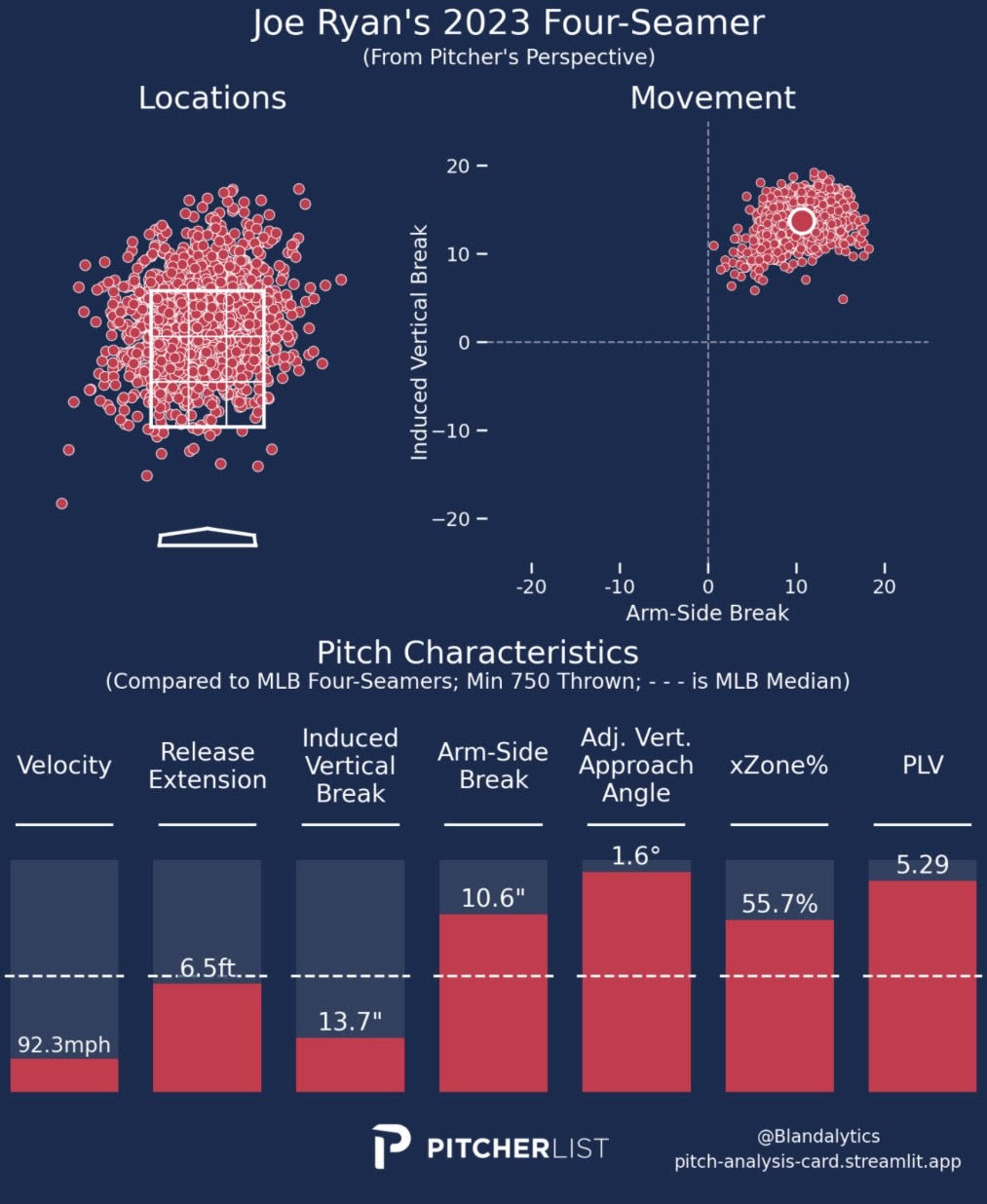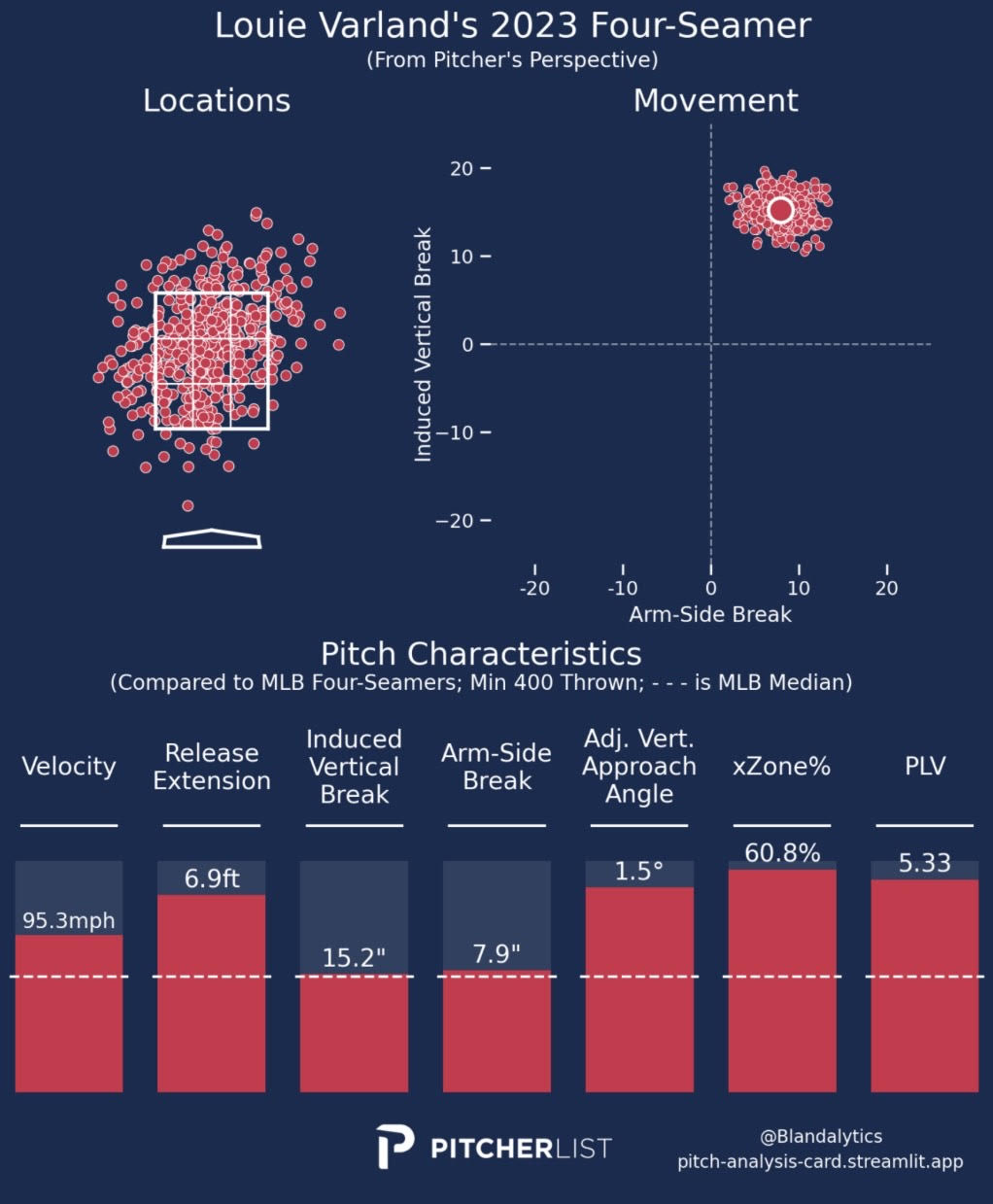Since the discovery of the effectiveness of induced vertical break at the advent of the Statcast era, the ability to generate swing-and-miss on four-seam fastballs up in the zone has been an integral piece to many pitchers’ arsenals. The “rising” effect of induced vertical break has historically made it difficult for hitters to make contact on these four seamers up in the zone, and utilizing this pitch can help each pitcher’s secondaries play up when located down in the zone. Couple the discovery of induced vertical break with the introduction of vertical approach angle, and living at the top of the strike zone with a high-ride four seamer has been the bread and butter for a lot of major league pitchers over the past handful of seasons.
The tide might slowly be turning back in favor of hitters in the battle for the top of the zone. As referenced in an article written by Eno Sarris of The Athletic last postseason, hitters performed better against four seamers located up in the strike zone in 2023 than any other season in the Statcast era.
Hitters are training to improve their ability to make contact on upstairs four seamers, utilizing methods such as focusing on trying to hit the top of the baseball on fastballs with ride. Two-strike approaches for hitters also appear to be changing. While the horizontally oriented approach of protecting the plate with two strikes has been commonly taught for generations, Driveline Baseball appears to be training hitters with more of a vertically oriented approach which allows for hitters to sit on high four seamers in two strike counts.
So what is the solution to hitters adjusting to four seamers up in the zone? The answer is not to entirely abandon utilizing high-ride four seamers up in the zone. Despite trends moving back in the hitter’s favor, induced vertical break is still incredibly valuable to the shape of a pitcher’s four seamer and this pitch shape still should be frequently used at the top of the zone. In addition, having a good four seamer is an excellent foundation for a pitcher to build the rest of their pitch arsenal around.
In my opinion, being able to utilize multiple fastballs within a pitch arsenal is the best way to mitigate this emerging trend, which I believe might lead to the re-embrace of the sinker. First, sinkers are still an effective pitch to add to an arsenal when a pitcher is susceptible to allowing hard contact to opposing hitters of the same handedness (particularly on their Four Seamer). Second, recent research by Ben Clemens of FanGraphs suggests that sinkers perform well when utilized upstairs, especially when they are located in the strike zone.
I am not suggesting that a pitcher should frequently use their sinker up in the strike zone, but being able to utilize this pitch from time to time can provide pitchers with an effective weak contact inducer when they are behind in the count. An effective up-in-the-zone sinker might allow for a pitcher’s four seamer to play up when utilized upstairs, as hitters may struggle to attempt to identify two different fastball shapes located in the same part of the strike zone.
Given these factors, I decided to look for pitchers who I believe should add a sinker to their pitch arsenals this season. The criteria I used to identify the candidates are as follows: the pitcher had to have allowed a high wOBAcon on four seamers to same-handedness hitters in 2023, display average command of the four seamer (as measured by FanGraphs’s Location+), and possess either plus induced vertical break or plus adjusted vertical approach angle on their four seam fastball. Using this criteria allows us to identify pitchers who stand to benefit from utilizing a Sinker to combat hitters’ adjustments up in the zone and generate weak contact throughout the rest of the strike zone. The query produced two pitchers who have tinkered with a sinker in either spring training or at the end of last season (Joe Ryan and Louie Varland) and two pitchers who I believe should consider adding a sinker to their arsenal in the future (Taj Bradley and Ryne Nelson).
Since making his major league debut at the end of the 2021 season, Joe Ryan has encountered difficulties surrounding his steep four seamer with effective secondary pitches. Ryan entered spring training with a new sinker in his pitch arsenal, and the addition of this pitch should allow him to induce more weak contact in the strike zone and generate more swing-and-miss with his four seamer up in the zone.

As shown by the player card above, Ryan has been the poster child for utilizing his four seamer up in the zone since he arrived in the major leagues, and the plus vertical approach angle that the pitch possesses allows for him to generate swing-and-miss on the pitch up in the strike zone despite below-average velocity and induced vertical break. Allowing a .556 in-zone wOBAcon and 46.6% ICR when utilizing the pitch to right-handed hitters last season, I hypothesize that hitters were simply sitting on the pitch due to the lack of outstanding secondary pitches in Ryan’s arsenal. With the addition of a sinker, Ryan should be able to induce more weak contact in the strike zone and could be a candidate to utilize the pitch effectively up in the zone as the steep VAA on his four seam fastball should give hitters difficulty to distinguish between the two pitches. Similar to how Bryan Woo utilizes his four seam/sinker combination, I am intrigued to see if Ryan starts to utilize his four seamer more up-and-away to right-handed hitters, allowing for his sinker to work more on the inner third of the plate and generate weak contact and broken bats. Adding a sinker should help improve Ryan’s fastball performance in 2024, even if he still needs a more effective secondary offering to bring his production to the next level in the future.
Another member of the Minnesota Twins has met the criteria for adding a sinker to their pitch arsenal. After experiencing issues with allowing hard contact on his four seamer last season, Louie Varland began utilizing a sinker as part of his pitch arsenal at the end of last season on September 12th. If Varland is able to deploy his sinker effectively this spring, he could find himself in the back end of the Twins starting rotation come Opening Day.

As shown by the player card above, Varland is similar to Ryan in that both pitchers possess plus adjusted vertical approach angle, allowing for their four seamers to generate swing-and-miss when utilized up in the zone. While Varland also possesses good command of the four seamer, the pitch has allowed a lot of hard contact, allowing a .594 in-zone wOBAcon and 53.3% ICR to right-handed hitters last season. Given the amount of hard contact opposing hitters made against his four seam fastball, Varland began utilizing a sinker on September 12th. While September 12th to the end of the season is a ridiculously small sample size, Varland was able to effectively mitigate the amount of hard contact he allowed on his fastballs to right-handed hitters. With continued usage of his sinker, Varland very likely will be the Twins’ No. 5 starter at the start of the regular season.
Since making his Major League debut at the beginning of last season, Taj Bradley has possessed one of the best four seam fastball shapes in all of Major League Baseball. Combining plus velocity with elite induced vertical break, Bradley’s four seamer has been graded very highly by nearly all pitch modeling metrics with a 131 Stuff+ and 5.41 PLV. Despite the pitch’s exceptional shape, Bradley has experienced unimpressive results with the offering, making him a prime candidate to add a sinker to his pitch arsenal in the future.

Despite possessing plus velocity and elite induced vertical break, Bradley has struggled to generate swing-and-miss with his four seam fastball, producing a 19.1% whiff Rate (15.8% vs. right-handed hitters) in 2023. In addition to the lack of swing-and-miss, the four seamer also gave up a lot of hard contact last season, allowing a .534 in-zone wOBAcon and 47.4% ICR to right-handed hitters. Adding a sinker to his pitch arsenal should help mitigate these hard contact issues and theoretically should help the four seamer generate more swing-and-miss due to hitters having to prepare for two different fastballs. It should be noted that while Statcast indicates that Bradley threw four sinkers in his spring training start against the New York Yankees on March 6th, it appears to me that these are simply classification errors as there was minimal movement differentiation between the sinker and the four seamer. If Bradley can add a sinker to his pitch arsenal and effectively induce more weak contact while improving the swing-and-miss ability of his four seamer, then it is possible for Bradley to reach his ceiling as one of the best starting pitchers in Major League Baseball in the near future.
Arguably the deepest sleeper on this list, Ryne Nelson could take the next step if he adds a sinker to his pitch arsenal in the near future. Since making his major league debut at the end of the 2022 season, Nelson has surrounded an above-average four seamer with average secondary pitches which has given him roughly average results throughout his short major league career. While his ceiling is probably limited, adding a sinker to his pitch arsenal should help his on-field results and could help him move up to the middle of the Arizona Diamondbacks starting rotation.

Nelson’s four seam fastball is the best offering in his pitch arsenal, possessing plus induced vertical break which allows for the pitch to play at the top of the zone. Similar to Ryan, Varland, and Bradley, this four seamer gave up plenty of hard contact last season, allowing a .520 in-zone wOBAcon and 46.8% ICR against right-handed hitters. Adding a sinker to his pitch arsenal should help Nelson induce more weak contact in the zone, and allow for Nelson to increase the whiff Rate on his four seamer (21.1% against right-handed hitters last season) due to hitters having to prepare for two different fastballs. With a 15.5% strikeout rate last season, it would be unreasonable to expect that Nelson could dramatically improve his swing-and-miss ability by simply adding a sinker. However, adding a sinker should increase his ground-ball rate due to the amount of weak contact the new offering should induce. While his ceiling is limited, adding a sinker to his pitch arsenal could make Nelson more effective next season as the Arizona Diamondbacks look to return to the postseason in a competitive NL West.
Photos courtesy of Icon Sportswire | Adapted by Aaron Polcare
